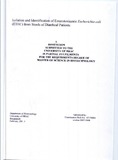| dc.contributor.advisor | Choudhury, Dr. Naiyyum | |
| dc.contributor.author | Naznine, Farhana | |
| dc.date.accessioned | 2010-09-27T04:51:22Z | |
| dc.date.available | 2010-09-27T04:51:22Z | |
| dc.date.copyright | 2008 | |
| dc.date.issued | 2009-01 | |
| dc.identifier.other | ID 07176006 | |
| dc.identifier.uri | http://hdl.handle.net/10361/243 | |
| dc.description | This thesis is submitted in a partial fulfillment of the requirement for the degree of Masters of Science in Biotechnology, 2008 | en_US |
| dc.description | Cataloged from PDF version of thesis report. | |
| dc.description | Includes bibliographical references (page 36-45). | |
| dc.description.abstract | Enterotoxigenic Escherichia coli (ETEC) is the major cause of diarrhea in children in the developing countries. It colonize the small intestine where they secret toxins. ETEC possess colonization factors (CFs) that are binds with the epithelial cell in small intestine. To determine the dynamic changing pattern of ETEC infection, a large scale surveillance should be carried out which will give a complete picture about the prevalence of CFs and toxin types of ETEC strains. The correlation of ETEC infection with patient's age, also provide vital information about the ETEC pathogenicity. For these reason, a surveillance program was conducted, to determine the prevalence of CF and toxin and to the ETEC infection with the age of patients.
In this study, diarrheal stools collected on the routine 2% surveillance sampling carried out in the International Centre for Diarrheal Disease, Bangladesh (ICDDR, B) were tested for ETEC February to April 2008.
Toxin-positive isolates were detected by enzyme-linked immunosorbent assay (ELISA), and reconfirmed with the PCR technique. The CFs was detected by the immunodot-blot assay by using specific monoclonal antibodies (Mabs). About 19% of stools were positive for ETEC and only 3% are mix infection with ETEC and V.cholerae. Of these, 19% ETEC isolates 44% produced LT and ST, 30% produced LT and the rest of 26% was ST producing. LT and ST¬producing ETEC were more frequently detected. Among the total ETEC isolated, highest isolation rate about 27% were isolated from children 2 to 5 years of age. About 16% of ETEC isolates expressed known CFs and only 3% were mix infection with ETEC and V.cholerae together. | en_US |
| dc.description.statementofresponsibility | Farhana Naznine | |
| dc.format.extent | 57 pages | |
| dc.language.iso | en | en_US |
| dc.publisher | BRAC University | en_US |
| dc.rights | BRAC University thesis are protected by copyright.
They may be viewed from this source for any purpose,
but reproduction or distribution in any format is prohibited
without written permission. | |
| dc.title | Isolation and identification of Enterotoxigenic Escherichia coli (ETEC) from stools of Diarrheal Patients | en_US |
| dc.type | Thesis | en_US |
| dc.contributor.department | Department of Mathematical and Natural Science, BRAC University | |
| dc.description.degree | M. Biotechnology | |

